Strategy is so important in the game of pickleball, as pickleball is not only a physical game, but also a mental game. If you are looking for pickleball strategies on how to win at pickleball, then you have come to the right place! Whether you are playing doubles pickleball or singles pickleball, this blog will break down pickleball strategies and pickleball tips to help you win on the pickleball court!
1. Consistently Serve Deep, to Backhands & in the Court
The first pickleball strategy tip starts with the first shot of every pickleball rally – the serve. Pickleball is a unique game because of its underhand serve. With that said, it is important to have extremely high accuracy on the serve because, unlike the sport of tennis, you only have one chance to get your serve in the correct service area. Also, the serve is the one shot in a pickleball rally that you have complete control over (but for, maybe, wind). As a result, the serve is one shot on the pickleball court that you can really perfect with practice and have very high accuracy for.

When it comes to placement of your serve, not only is it important for the serve to land in the proper service box, but it is also important to give yourself an advantage on the serve by making the return of serve more difficult for your opponents. To make a difficult return of serve for your opponents, try the following two tips:
- Target your opponents’ weaker side, which is often their backhand side, as most pickleball players have stronger forehand shots than backhand shots; and
- Hit your serve deep into the service box, which will push your opponents back beyond the baseline and make for a more difficult longer return for your opponents (and, hopefully, an easier third shot for you and your partner). However, while a deep serve is the rule of thumb, be sure to avoid hitting your serve out of bounds due to giving yourself too small of a margin for error.
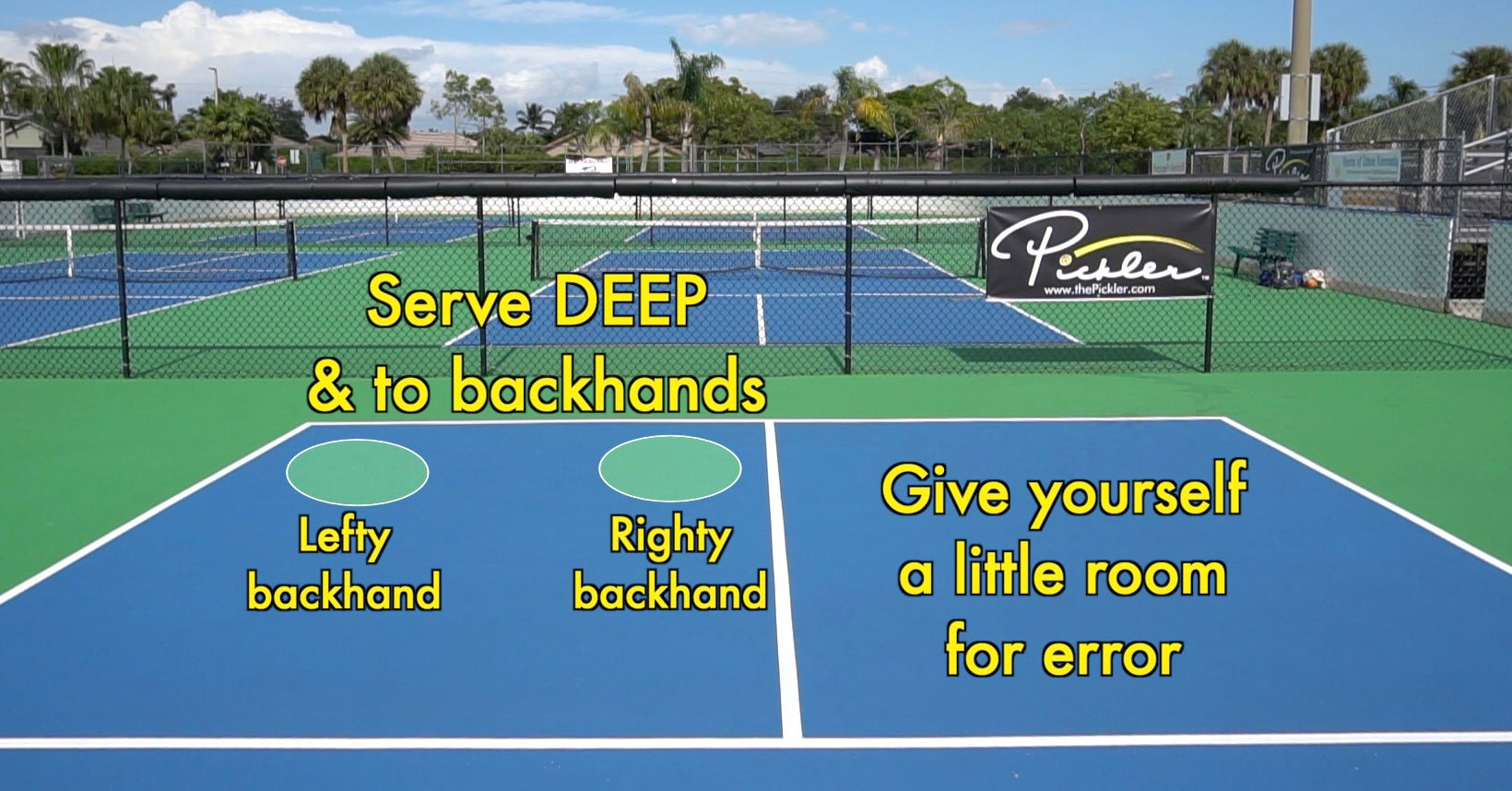
2. Return Deep, to Backhands & to the Opponent with a Weaker Third Shot
The second pickleball strategy tip relates to the second shot of every pickleball rally – the return of serve. Like the serve, the return of serve should be deep in your opponents’ side of the pickleball court (in other words, close to the baseline, but within the court). This is especially true if you are playing a team that likes to drive the third shot – commonly known as “bangers.” By keeping the pickleball deep in the pickleball court, you will make for a more difficult drive for the opposing team and give you and your partner more time to react to the driving shot.
However, like the serve, while a deep return is the rule of thumb, be sure to avoid hitting your return out of bounds due to giving yourself too small of a margin for error. Consider hitting most returns in the middle of the court to give yourself the most margin for error. A missed return results in an easy point for your opponents!

The return of serve should also target not only your opponents’ weaker side (which is often their backhand side), but also the player of the opposing team that has a weaker third shot. This is because, unlike the serve, you may hit the return of serve anywhere on your opponents’ side of the pickleball court. This means that you can target a specific player. So, in summary:
- Hit your return of serve deep in the court;
- Target the player of the opposing doubles team with the weaker third shot; and
- Target the weaker side of such weaker player (which is likely his or her backhand side).
If you have mastered the deep return of serve, then also consider the following more advanced pickleball strategy tips for the return of serve:
- Most points in pickleball are won at the Non-Volley Zone Line (also known as the Kitchen Line). As a result, it is important to get to the Non-Volley Zone Line as quickly as possible. As the returning team, you should be able to get to the Non-Volley Zone Line immediately after hitting your return of serve.

- Windy days, as the wind may cause havoc on your shot and carry it out of bounds; and
- Playing against bangers, as a lob return of serve will have the tendency to have a high bounce, which will more easily allow the bangers to hit a drive (as opposed to a low return of serve that is below the pickleball net where the bangers would have to hit up on the pickleball, which may cause the pickleball to sail out of bounds).
- Consider putting some spin on your return of serve. This will help make for a more difficult shot for your opponents. For instance, consider slicing your return of serve (in other words, hitting your return of serve with backspin). Slice on your return of serve will:
- Make for a more difficult shot for your opponents because of the spin;
- Give you and your partner more time to get to the Non-Volley Zone Line because the backspin will likely cause the pickleball to travel at a slightly slower pace; and
- Keep the pickleball low when it makes contact with the pickleball court (as opposed to top spin, which will typically cause the pickleball to take a higher bounce).
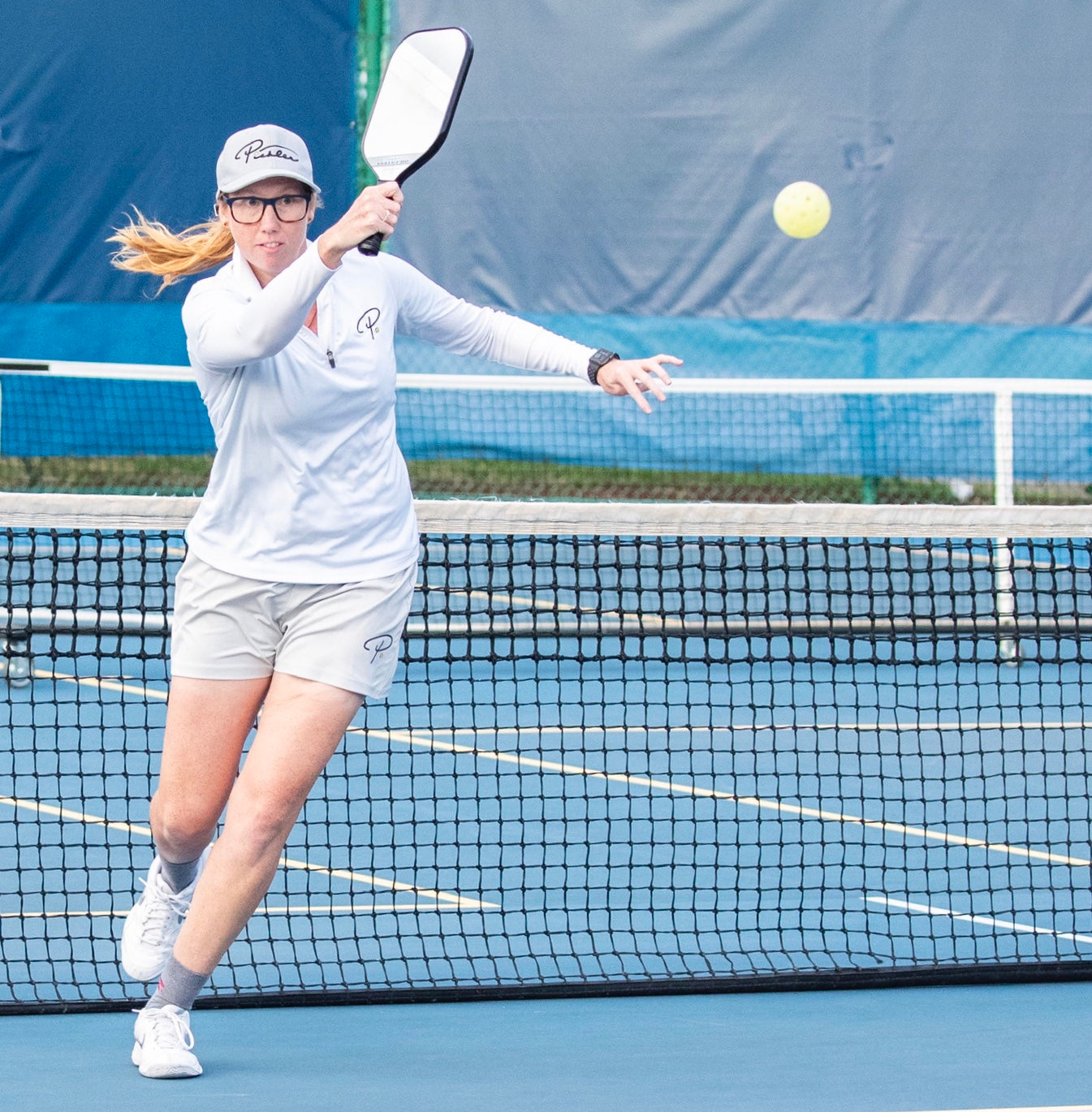
- If you are playing a team with one player that loves to poach (meaning to charge the pickleball net and take the next shot (the fifth shot) in front of their partner), then consider returning the pickleball to the poacher in order to eliminate his or her ability to crash the pickleball net. By returning the pickleball to the poacher, the poacher will be forced to hit the third shot and you will keep them back in the court.
3. Move Your Feet & Bend Your Knees
The next pickleball strategy tip may sound simple, but it is more difficult than you think and most pickleball players neglect to do it on a consistent basis – move your feet and bend your knees!
Your feet are so important in your shot execution. As a result, it is important to move your feet and position yourself so that you can hit the pickleball out in front of you (the next pickleball strategy tip!). Also, it is important to bend your knees and get low so that you (a) more effectively hit the low balls in pickleball (which is a key goal on the pickleball courts – keep the pickleball low – more on this below!) and (b) engage the most powerful muscles on your body, which are your leg muscles.

So, consciously tell yourself to move your feet and bend your knees. You’d be surprised with the difference in your shot execution!
4. Watch the Pickleball & Hit the Pickleball Out in Front
Pickleball 101: Watch the pickleball hit your paddle! Again, another easy pickleball tip, but often neglected. There are many distractions on the court. It is important to focus on your shot and execute one shot at a time. So, watch the pickleball hit your paddle – and ignore the opposing player, the opposing player’s paddle, spectators, your partner, your next shot, etc.

To help you watch the pickleball, be sure that you are hitting the pickleball out in front of your body. As noted above, hitting the pickleball out in front of your body starts with moving your feet. By hitting the pickleball out in front of your body, you will set yourself up for success because you will:
- Have better pickleball technique on your shots, which will result in less errors;
- Keep your swing relatively compact, so you are ready for the next shot and do not overswing;
- Put yourself in a position to keep moving forward and otherwise stay at the Non-Volley Zone Line, where most points are won; and
- Be able to watch the pickleball hit your paddle!
5. Be in “Pickleball Ready” with Your Pickleball Paddle Up
If you have checked out our online video lesson collection called My Pro Pickleball Coach, then you have heard us use the phrase “Pickleball Ready.” Pickleball Ready is the ready position you should be when you start transitioning up the pickleball court and entering into the “No-Man’s or No-Lady’s Land” or the “Transition Area,” as well as at the Non-Volley Zone Line. Pickleball Ready consists of the following:
- Feet shoulder width apart;
- Knees bent and compress your body with your weight on the balls of your feet;
- Paddle facing forward or facing 10 or 11 o’clock if you imagine that you are standing on a clock face (or 2 or 1 o’clock position if you are a lefty); and
- Paddle forward and paddle head up.

It is important to be in Pickleball Ready, as the game of pickleball can happen so fast as you move closer to the pickleball net. To give yourself the best chance to react to a fast-moving pickleball, your paddle should be up in front of your body. This will cut down on your reaction time, as it is one less thing to do – you do not have to raise your paddle to hit the pickleball because your paddle is already there.
Also, always anticipate that the pickleball will come back! Do not let your guard down because you think you hit a good shot – expect the pickleball to come back.
6. Make a Decision on Shot Selection & Commit to It
Decision making on the pickleball court is so important. Good shot selection, playing the higher percentages (more on this strategy later in this blog), and deciding where to position yourself on the pickleball court plays a huge factor in winning or losing a pickleball game. With that said, it is important to make quick decisions and commit to your decision.
Where pickleball players often make mistakes is by second guessing themselves or changing their mind on their shot selection. The time to make a decision on a shot and execute that shot is only fractions of a second. As a result, if you change your mind, you will likely make a mistake because you will not give yourself enough time to execute the change.

So, make a decision on your shot selection and commit to it! It is better to go 100% on a “questionable” decision than 50% or less on a “good” decision.
7. Play to Your Strengths & Your Opponents’ Weaknesses
The basic cornerstone of pickleball strategy is to play to your strengths and your opponents’ weaknesses. For instance, if you have a great drive and power game, while your opponents have a great soft game and dinking game, then drive the pickleball more often and try to speed the pickleball up. Avoid the dinking rallies. If you have a great lob and your opponents have a terrible overhead or have poor mobility, then try to lob your opponents. If your opponents have amazing forehand drives, but weak backhand drives, hit to their backhands. Know your strengths on the pickleball court and use them! Figure out your opponents’ weaknesses and exploit them!
8. Stay Patient
Patience is so important in the sport of pickleball. Exercising patience as a player on the pickleball court is a skill that too many players do not have. Many times on the pickleball court, the player who first speeds up the pickleball will lose the point, as the counterattack by his or her opponents is better than the initial speed up. As a result, it is important to have patience, let the point build, and attack the pickleball only when the shot is there (for instance, the pickleball is at or above the top of the pickleball net).

Be patient! Only attack attackable pickleballs at or above the top of the pickleball net, rather than unattackable pickleballs below the net.
9. Keep the Pickleball Low
One of the hardest things to do in the sport of pickleball is to keep the pickleball low (while still over the net). A low pickleball will prevent your opponents from being able to go on the offensive with an aggressive shot. For instance, a low return of serve will likely result in your opponents hitting a drop shot, rather than a drive. Also, a low shot at the Non-Volley Zone Line will result in a dink, rather than a fast-paced volley. A low pickleball will also cause your opponents to hit up on the pickleball, which will hopefully lead to a pop up by them and an offensive, aggressive shot by you.
The goal for you and your partner in doubles pickleball is to keep the pickleball low. To do this, consider your paddle angle, as well as the pace you are putting on a pickleball at different heights.
-
Paddle Angle:
- A paddle angle that is open to the sky or flat will cause the pickleball to have more height.

- A paddle angle that is closed to the sky or parallel to the net will cause the pickleball to have less height.
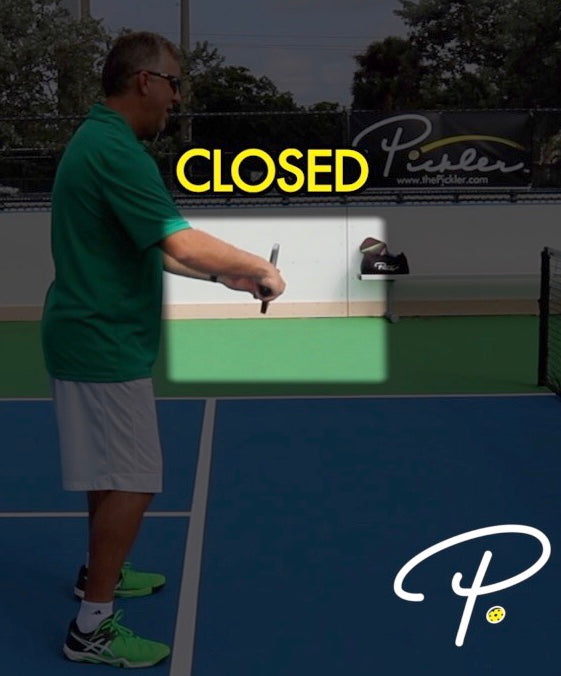
-
Pace of Your Shot:
- When hitting up on the pickleball with an open paddle angle, slow the pace of the pickleball down. The slower pace will allow you to keep the pickleball low and in the pickleball court.
- When hitting down on the pickleball with a closed paddle angle, consider speeding up the pickleball and hitting the pickleball down into the pickleball court.
Keep the pickleball low, be patient, and go on the attack when your opponents pop up the pickleball!
10. Communicate, Communicate, Communicate
For doubles pickleball, one strategy that is key to winning pickleball is strong communication with your partner. You and your partner should communicate during a rally and between shots. For instance, communicating who takes pickleballs that land in the middle, who is running down the lob, and whether or not to let certain shots go by that will be landing out of bounds—“OUT” or “BOUNCE IT!”
You and your partner should also communicate with each other between points. For instance, should your strategy change, or are one of you seeing a weakness in your opponents.
Lastly, you and your partner should also communicate to encourage each other. Nice shot! Let’s go! This is especially true if the opposing team is picking on the “weaker” player. If you are the player that is not being picked on, then your job is to be a cheerleader for your partner and insert yourself where possible to help relieve pressure. Be a positive force for your partner on the pickleball court. Most people respond better to positivity than negativity.

Communicate, communicate, communicate!
11. Let the Out Balls Go
Whether you are playing singles pickleball or doubles pickleball, one of the best skills that you can have on the pickleball court is the ability to let the out balls go. This is especially true when you are playing against players that like to drive the pickleball. Be on the lookout for out balls! Duck and dodge out balls. Do not help your opponents stay in the point.
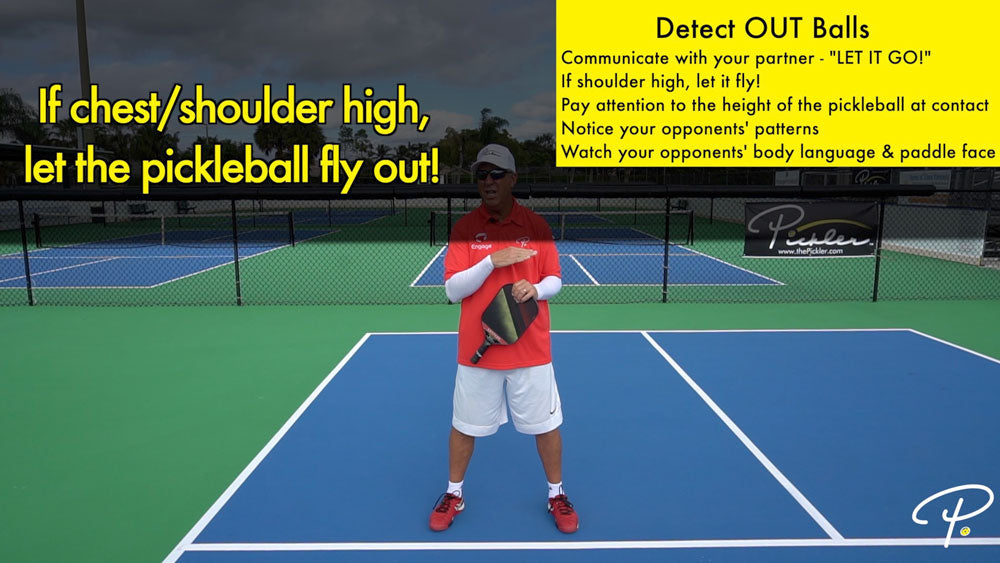
To improve your detection of out balls, consider the following:
- Communicate with Your Partner – Two heads are better than one, so work with your partner to detect out balls. If you see an out ball, scream and yell at your partner—“NO!” or “LET IT GO!” or “BOUNCE!”
- Let the Shoulder Height Drives Go – If your opponents drive a pickleball at you with pace that is about chest or shoulder height, let it go. Your opponents’ drive is probably out. This is especially true if your opponents drove the pickleball from the Non-Volley Zone Line.
- Pay Attention to the Height at Contact – If your opponents drive a pickleball that sits below the net, consider letting it go. This is because your opponents will have to hit up on a low-sitting pickleball to hit it over the net. By hitting up on the pickleball, your opponents will send the pickleball on a trajectory that is probably going out of bounds.
- Patterns of Play – As you play a few points with your opponents, try to analyze their patterns of play. Do your opponents consistently drive the pickleball on every shot? Once your opponents get to a certain place on the court, are these drives too high and going out of bounds? Try to pick up on any patterns to help you anticipate and detect out balls.
- Body Language – In addition to patterns of play, pay attention to your opponents’ body language and paddle face. For instance, a big backswing and flat or closed paddle face will indicate a drive is coming your way. Use these clues to help you anticipate shots, including out balls.
Remember to the let the out balls fly out of play. Out balls are easy points for you and your partner. Hitting an out ball keeps your opponents in the point, which is obviously something that you want to avoid.
12. Dink Crosscourt (Most of the Time)
As a reminder, it is important to keep the pickleball low, as this will prevent your opponents from going on the offensive with an aggressive shot. To keep the pickleball low requires strong dinking skills.
One tip for strong dinking is to hit most dinks crosscourt (as opposed to straightforward or in the middle of the pickleball court). This is because the crosscourt dink gives you the most margin for error, as (a) a crosscourt dink will travel over the lowest part of the pickleball net, which is in the middle; (b) you are hitting into a natural angle; and (c) you have more court space to dink into (as opposed to a straightforward dink). In other words, the crosscourt dink is more forgiving and you do not need to be quite as perfect. As a result, you should dedicate yourself to be extremely proficient at the crosscourt dink, and 70% to 80% of your dinks should probably be crosscourt.
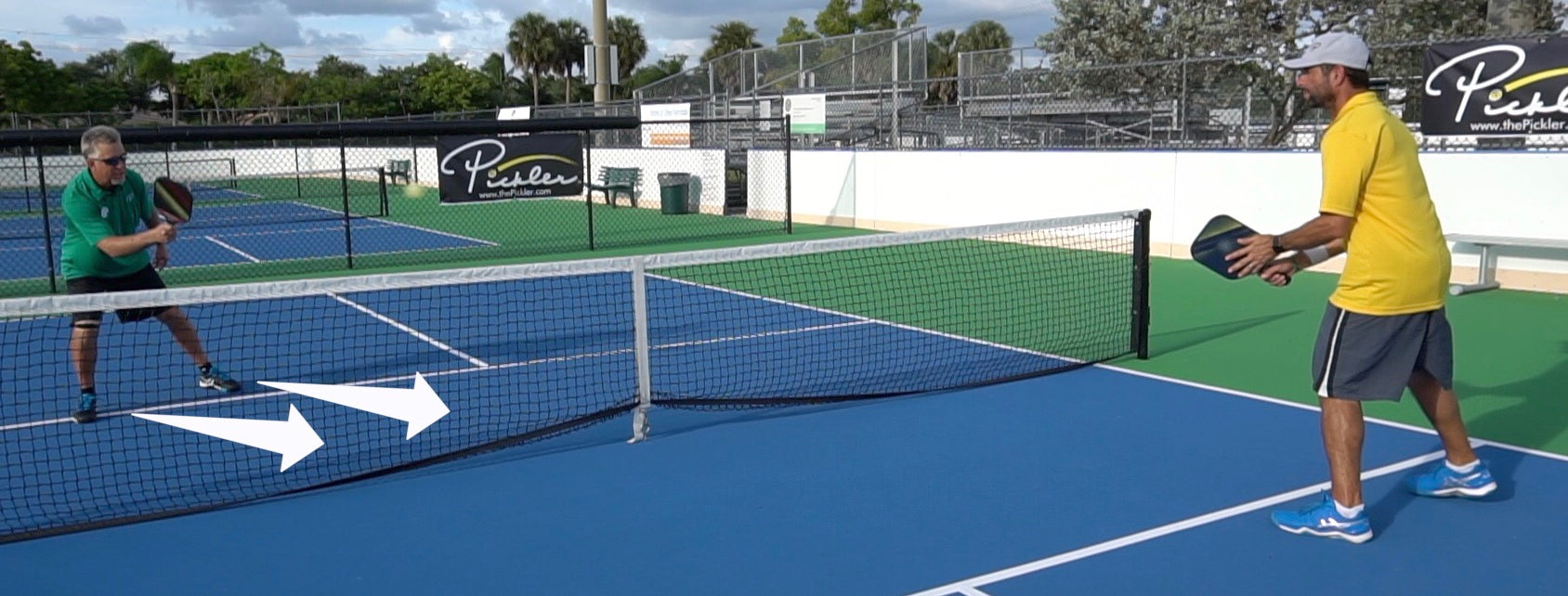
It is important to note, however, that not all dinks should be crosscourt. You must mix up your dinks (and your other shots, such as an offensive lob) from time to time in order to stay unpredictable in your pickleball strategy. Also, when you are in trouble—for instance, your opponents pull you out wide with an aggressive dink—then a crosscourt dink is a very difficult shot to execute and is very low percentage. As a result, if you are in trouble and off balance, consider resetting the pickleball will a simple straightforward dink. However, beware of an Erne from your opponents! Be sure to hit the dink slightly toward the middle and out of reach of an Erne-ing opponent.

13. Over the Pickleball Net, Between the Lines & Mostly Down the Middle
Whether you are playing doubles pickleball or singles pickleball, the key to winning at pickleball is hitting the pickleball over the pickleball net and between the lines of the pickleball court one more time that your opponents. (If only it were that easy?!) One easy tip to help accomplish this is to hit most of your shots on the pickleball court down the middle—with the exception of dinks, which most of your dinks should go crosscourt.
As the saying goes, “down the middle solves the riddle.” This is usually true because the middle part of the pickleball court provides you with the highest margin of error, as the net is at its lowest point and you can miss a little to the left or a little to the right, while keeping the pickleball in play. Down the middle shots are also effective if there is a large gap between your opponents, or if you can get your opponents to fight with each other over who should take the middle shot between them.
One additional good pickleball tip that I first learned from Joe Baker in his book “At the Line Pickleball: The Winning Doubles Pickleball Strategy,” is to not only target the middle of the pickleball court, but to target the foot in the middle of the court that is on your opponents’ backhand side. For instance, if you are playing two right-handed players, then you would target the left heel of the opposing player on the right-hand/even side of the pickleball court. The left heel would be the backhand-side foot in the middle of the pickleball court.

*For those pickleball referees out there, the pickleball bounced in the picture above, so this is not a foot fault! 🙂
Want More Pickleball Strategy Tips and Techniques?
If you want more pickleball tips and strategies on every aspect of your pickleball game, check out Pickler’s online video lesson collection called My Pro Pickleball Coach. My Pro Pickleball Coach is a fraction of the price of one clinic or even one lesson, and features over 140 video lessons (over 7 hours of instruction!), as well as a corresponding e-book. These online video lessons are available on demand 24/7 and breakdown every aspect of the sport of pickleball, including pickleball drills, strategy, and advanced concepts, so you will play your best pickleball.
Your Equipment Matters!
The quality of your pickleball paddle will affect your pickleball game! To get a pickleball paddle that works best with your game, head over to our friends at Fromuth Pickleball. Also, don’t forget to use our exclusive discount code “10PICKLER” to earn you 10% off (to note, some exclusions apply; court equipment, Babolat, and Selkirk-branded merchandise and paddles are excluded)!






